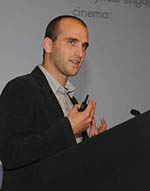Respected Product Manager Brings Workflow Expertise to Renowned Systems Integration Company
SUN VALLEY, Calif. (February 16, 2011) – ALT Systems, a full service systems integrator and workflow solutions provider, has appointed Bruno Munger as Director of Technical Sales. Munger will collaborate with ALT Systems’ customers to design workflow solutions, integrate cutting-edge hardware and software systems, and adapt technical infrastructures for the most demanding post production and visual effects work. His new position is effective immediately, as he joins his colleagues this week at the Hollywood Post Alliance (HPA) Tech Retreat in Rancho Mirage, Calif.
Bruno Munger, Director of Technical Sales, ALT Systems
“Bruno Munger possesses a rare combination of talents — inventive designer, business-savvy technologist, dynamic leader and passionate customer advocate,” says Jon Guess, president of ALT Systems. “Since ALT Systems was founded in 1995, we have been dedicated to offering expert advice, client support and training. Bruno brings a new skill set to our long-standing, solid business offerings, as well as elevates the growth potential of what we can offer current and future clients.”
Munger comes to ALT Systems with over 17 years of experience in the media and entertainment industry, with specialties in workflow design for file-based image capture, file-based image digital delivery, and 2D/3D digital intermediate. He has been involved in product management for industry-leading companies such as Digital Vision, Autodesk, MTI, and Snell & Wilcox.
With over 12 years in software development, Munger is probably best known for his work for Autodesk Lustre and Nucoda Film Master. He joined Autodesk in early 2003 and successfully helped the North American sales team significantly increase market share for Lustre. In 2005, he moved on to product management. As a member of the R&D team, Bruno was invaluable in helping the product grow from a handful of clients to an industry standard, working closely with customers as their digital intermediate offerings were taking form. In 2009, he joined Digital Vision to help expand their market share and transport the Nucoda product line to broadcast and episodic television.
“ALT Systems is one of the best-kept secrets in the industry, and a company poised for tremendous growth,” says Munger. “They have a solid reputation for offering the best solutions. I look forward to working closely with their outstanding team on building awareness and taking customer service to the next level. I believe that my extensive experience in meeting clients’ unique needs in a dynamic industry of emergent technologies will be an asset to me and the rest of the ALT Systems team. We will continue to give our customers a clear advantage when managing the evolving workflow challenges that face facilities in today’s digital environments. I look forward to solving the many technological and architectural challenges that will drive this marketplace far into the future.”
In his new role, Munger will work closely with facility engineers and managers, colorists, editors, and VFX supervisors to find workflow and systems solutions that manage today’s myriad of digital acquisition formats and post production requirements to position them for success in their field.
“As pre-production, pre viz, post production, and visual effects timelines and tools intermingle, there is a growing need in the production and post production community for experts to help plan the route and pave the way,” adds Munger. “Jon and the ALT Systems team have a phenomenal track record of supporting their customers. I am excited to help ALT Systems customers with answers, ideas, and creative solutions.”
About ALT Systems
ALT Systems Inc. is a Los Angeles-based systems integrator and workflow solutions provider, offering superior compositing, rendering, editing, color correction, digital intermediate (DI), 2D/3D, restoration, large format film recording, and SAN and NAS networking and storage options to the post production and visual effects industry. Founded in 1995 and privately owned, the company is a leading solution provider in the global entertainment and media marketplace. Key customers include Deluxe, Technicolor, CBS, Rhythm & Hues, Hydraulx, Tata Elxsi and IMAX.
The cornerstone of ALT Systems’ solutions is Autodesk’s Creative Finishing products. Over the past several years, ALT Systems has consistently been recognized as Autodesk’s top systems reseller in the Americas, delivering Flame, Smoke, Lustre and Flare to both large and boutique-sized facilities.
ALT systems also offers products from top manufacturers including Apple, Qlogic, AJA, Intel, Brocade, Cine-tal, Xyratex, HP, Rorke Data, Quantum, BlueArc, Bright Technologies, and DataDirect Networks, among others.
For more information, visit www.altsystems.com.

 DS: I work for Germany’s largest post production company
DS: I work for Germany’s largest post production company